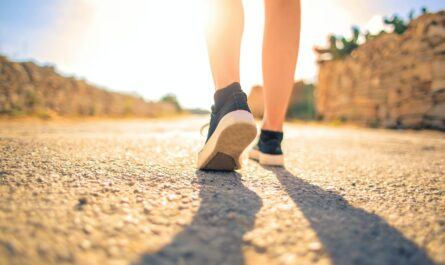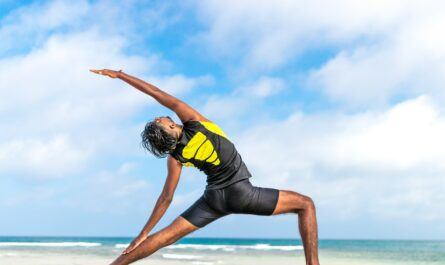Runners need to stretch! It will keep the muscles in the body flexible so that the muscles and joints are at their fullest range of motion.
Why?
Running will make our legs more powerful, but unfortunately, after many miles, the hard work will shorten and tighten our muscles and tendons as well. Over time our mobility will decrease and imbalances, scar tissue, and tension will develop. This will slow us down and pave the way for common overuse running injuries like IT Band Syndrome, Plantar Fasciitis, and Achilles tendonitis.
 When should we stretch?
When should we stretch?
It is recommendable to develop a pre- and post-workout routine. As warm muscles respond much better, stretch right after your warmup, before you start your run. To promote better recovery, repeat the stretching exercises after your run. It will help to prevent injuries.
 The DO’s and DON’TS of Stretching
The DO’s and DON’TS of Stretching
It is important to adhere to the following guidelines, both for safety and for maximizing the potential benefits of stretching.
- Keep breathing. Holding your breath causes muscle tension and may raise blood pressure. The more relaxed your in- and exhalations are, the more relaxed your muscles will be. Extend your exhalations for deeper and longer stretches.
- Don’t push beyond the point of pain. Stretching tight muscles may be a bit uncomfortable, but you should never feel any sharp, sudden pain. If you do, then you should stop immediately. Don’t push the stretch too far.
- Never skip. Consistency will gradually build flexibility and range of motion. Regular stretching for a couple of minutes, a couple of times per week, is a better way to increase your flexibility, than only once a week for a longer time.
- Don’t stretch cold muscles: Always make sure your muscles are warmed up before you stretch them, at least long enough to get the blood flowing through the body.
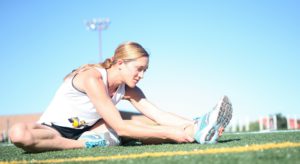 Training Routines
Training Routines
In the beginning, it may feel overwhelming to remember all the different stretches and how to perform them correctly, but after a few sessions, the next 13 stretching exercises will become part of your training routine:
13 Stretching Exercises for Runners
Stretching the key muscle areas for runners can be done at any place before and after your run. They can all be performed in a standing position and they don’t require any equipment. Remember to keep breathing during each stretch! Slow exhalations will make your stretch deeper and easier.

1. Side Core
- Stand upright with both arms in the air
- Grab with your right hand the left wrist above your head
- Lean the upper body to the right until you feel a stretch on the left side of your core. Don’t lean forward or backward during the stretch.
- Hold for 10-20 sec and repeat on the other side.

2. Hips Circle
- Stand upright with both hands on your hips and your feet hip-width apart.
- Circle your hips in one direction. Make the circles wide, until you’re working your full range of motion.
- To deepen the stretch, on the last round, pause briefly at the front, back, left, and right points in the circle.
- Repeat for six to 10 rotations in one direction, and then switch directions.
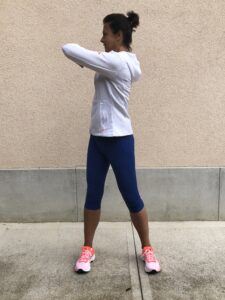
3. Upper Body Twist
- Stand upright.
- Hold interlock your fingers in front of you and point your elbows to the sides.
- Twist your upper body by turning your shoulders to each side, while keeping your feet fixed on the floor and holding legs and hips straight.
- Feel the stretch in your spine and core.
- Repeat for 6-10 twists.

4. Front Upper Leg: Quadriceps
The quadriceps cover most of the front and sides of your thighs.
- Stand upright with the feet hip-width apart. If necessary, put the left hand on a wall or sturdy object for balance.
- Bend the right knee and bring the right foot up behind the body toward the buttocks.
- Grab the right foot with the right hand.
- Keep the right knee pointed toward the floor and gently push the hips forward very slightly, keeping the knees and thighs together.
- Hold for 10-20 seconds and then switch legs.

5. Front Upper Leg: Psoas
The psoas (pronounced “so-az”) muscle is on the front of your spine and connects the lower back to the upper thigh.
- Start by putting your right foot forward so that you are in a lunge.
- Keep your chest and shoulders upright, push your pelvis, and tighten your buttocks. You should feel the stretch on the front of your hip on your back leg
- Hold for 10-20 seconds.
- Switch sides.

6. Back Upper Leg: Hamstring
- Stand with the feet together or shoulder-width apart.
- Keep the knees straight but not locked.
- Bending at the hips, slowly lower the head down toward the knees, keeping the back as straight as possible.
- Reach the fingers toward the toes, and let the neck relax.
- Hold for up to 10-20 seconds.
- Rise slowly back up to standing.

7. Hips and Glutes
- Stand upright
- Bring your right ankle to your left knee while keeping balance on your left leg.
- Bend your left leg into a semi-squad until you feel the stretch on the outer side of your right hip and glutes.
- Hold for 10-20 sec, then switch sides.
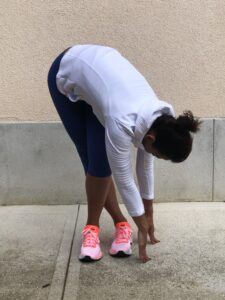
8. Outer Upper Leg and Calves: Iliotibial band (ITB)
Your body’s iliotibial band (ITB) runs on the outside of your thigh between your hips and the sides of your shins and calves. New runners who push themselves too hard can easily injure this area.
- Cross your left foot over your right foot.
- Lean forward and reach toward your left side.
- You will feel the stretch in your right leg all the way from the right side of the hip down to the right side of the calve.
- Hold for at least 10-20 seconds.
- Repeat with the other leg: cross right foot over left foot, and lean forward and reach to the right side.
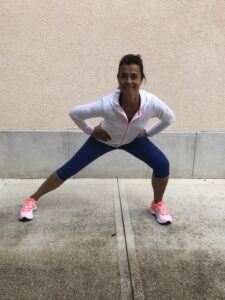
9. Inner Thighs: Groin
- Stand with your feet spread apart in a wide stance.
- Without moving your left leg, lean to the right and bend your right knee until you feel a stretch at your left inner thigh.
- Hold for 10-20 seconds, then switch sides.

10. Back Lower Leg: Calf
- Stand with your right foot behind your left.
- Bend your left leg forward while keeping your right leg straight. Be sure not to bend the right knee.
- Keep both feet flat on the ground, toes pointing straight forward.
- Straighten your back and hold the pose for at least 30 seconds.
- You should feel this stretch anywhere from the back of your knee down to your ankle.
- Repeat with the other leg.
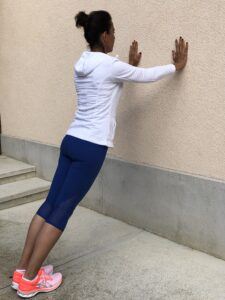
11. Calves – wall push
- Face a wall, standing about an arm’s length away from it.
- Put both hands on the wall at shoulder height.
- Take a step backward.
- Press the hands into the wall, lean forward, and keep both heels on the floor.
- Feel the stretch in the calves.
- Hold for 10-20 seconds.

12. Achilles Tendon – against wall/tree
The Achilles tendon connects the heel bone to the calf muscle and helps raise the heel off the ground while walking or running.
- Stand one step in front of a wall, or tree, or the pedestrian’s side.
- Place your right foot toes up against it.
- Keep your upper body straight. You can keep your hands against the wall/tree for balance.
- Slightly push your hips towards the wall and feel the stretch in your Achilles Tendon.
- Hold for 10-20 sec, and switch sides.

13. Achilles Tendon – staircase heel drop
- Hold on to the railings of the staircase.
- Put the balls of your feet on the edge of the bottom step.
- Let your heels slowly drop. Be careful not to overstretch or slide off the step.
- Hold for 10-20 seconds. Complete 3 reps.
4 Extra stretching exercises, while lying or sitting down
When you are at home or at a location where you can lie or sit down on the floor, you can perform the following extra running stretches.

1. Buttocks: Gluteal Muscles (glutes)
- Lie on your back with knees bent and feet flat on the floor.
- Cross your left ankle over your right knee.
- Grab behind your right knee and bring the leg toward your chest. You should feel the stretch in your buttocks.
- Hold for 10-20 seconds, then switch sides.
 2. Seated hamstring stretch
2. Seated hamstring stretch
- Sit on the floor with the right leg extended
- Move the left foot toward the top of your right inner thigh.
- Bend forward at the waist, keeping the back straight.
- Reach to or hold onto the right foot, ankle, or lower leg (depending on flexibility), feeling the stretch in the back of the right hamstring.
- Hold the position for 10-20 seconds and repeat on the other leg.
 3. Spine stretch
3. Spine stretch
- Lie down on your back.
- Keep your left leg straight and bend your left knee so that your leg touches your chest.
- Rotate your left leg until your knee is touching the ground in front of your right leg.
- Rotate your right arm, head, and upper back to the left until you feel a stretch in your spine.
- Hold for 10-20 seconds and repeat on the opposite side.
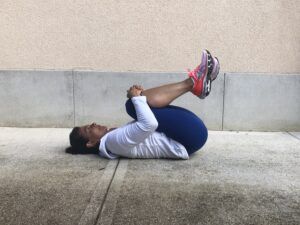 4. Lower back
4. Lower back
- Lie on your back.
- Grab both of your knees and pull them up to your chest until you feel a stretch.
- Hold for 10-20 seconds.
Hopefully, this post helps you to make stretching part of your training schedule. Please share with other runners among your contacts, and simply hit the social media buttons. Thank you! Should you have any questions, feel free to send me an e-mail at an*******@mo*********.com or leave that comment below and I will get back to you.


